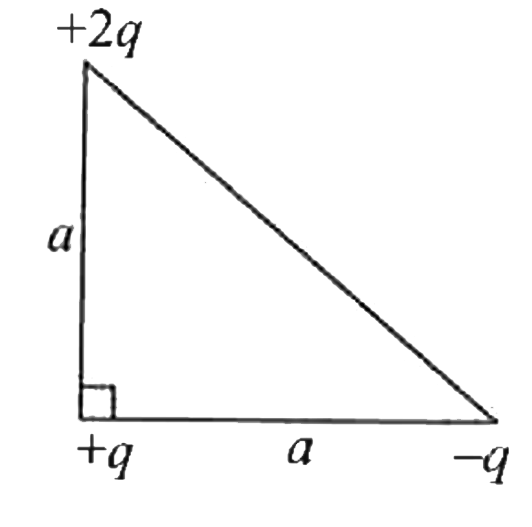Let two non-collinear unit vector ˆa a n d ˆb form an acute angle. A point P moves so that at any time t, the position vector OP(whereO is the origin) is given by ˆacost+ˆbsint.WhenP is farthest from origin O, let M be the length of OPandˆu be the unit vector along OP. Then (a)ˆu=ˆa+ˆb∣∣ˆa+ˆb∣∣andM=(1+ˆa.ˆb)1/2 (b) ˆu=ˆa−ˆb∣∣ˆa−ˆb∣∣andM=(1+ˆa.^)1/2 (c) ˆu=ˆa+ˆb∣∣ˆa+ˆb∣∣andM=(1+2ˆa.ˆb)1/2 (d) ˆu=ˆa−ˆb∣∣ˆa−ˆb∣∣andM=(1+2ˆa.ˆb)1/2Solution in Bengali
,ˆu=ˆa+ˆb∣∣ˆa+ˆb∣∣andM=(1+ˆa.ˆb)1/2
,ˆu=ˆa−ˆb∣∣ˆa−ˆb∣∣andM=(1+ˆa.ˆb)1/2
ˆu=ˆa+ˆb∣∣ˆa+ˆb∣∣andM=(1+2ˆa.ˆb)1/2
,ˆu=ˆa−ˆb∣∣ˆa−ˆb∣∣andM=(1+2ˆa.ˆb)1/2
The correct Answer is:a
∣∣∣−−→OP∣∣∣=∣∣ˆacost+ˆbsint∣∣
=(cos2t+sin2t+2costt∈tˆa.ˆb)1/2
(1+2costt∈tˆa.ˆb)1/2
(1+sin2tˆa.ˆb)1/2
∣∣∣−−→OP∣∣∣max=(1+ˆa.ˆb)1/2when t=π/4
ˆu=ˆa+ˆb√2∣∣ˆa+ˆb∣∣√2=ˆa+ˆb∣∣ˆa+ˆb∣∣
Topper's Solved these Questions
- DIFFERENT PRODUCTS OF VECTORS AND THEIR GEOMETRICAL APPLICATIONS BOOK - CENGAGE PUBLICATIONCHAPTER - DIFFERENT PRODUCTS OF VECTORS AND THEIR GEOMETRICAL APPLICATIONS EXERCISE - Multiple correct answers type
11 Videos
- DIFFERENT PRODUCTS OF VECTORS AND THEIR GEOMETRICAL APPLICATIONS BOOK - CENGAGE PUBLICATIONCHAPTER - DIFFERENT PRODUCTS OF VECTORS AND THEIR GEOMETRICAL APPLICATIONS EXERCISE - Exercise 2.3
18 Videos
- CONIC SECTIONSBOOK - CENGAGE PUBLICATIONCHAPTER - CONIC SECTIONSEXERCISE - All Questions
1167 Videos
- LIMITS AND DERIVATIVESBOOK - CENGAGE PUBLICATIONCHAPTER - LIMITS AND DERIVATIVESEXERCISE - All Questions
689 Videos
Similar Questions
Let →a=a1ˆi+a2ˆj+a3ˆk,→b=b1ˆi+b2ˆj+b3ˆk and →c=c1ˆi+c2ˆj+c3ˆk be three non- zero vectors such that →c is a unit vectors perpendicular to both the vectors →a and →b. If the angle between →a and →b is π6 then
∣∣ ∣∣a1a2a3b1b2b3c1c2c3∣∣ ∣∣2 is equal to
View SolutionIf →a,→b,→cand→d are four non-coplanar unit vectors such that →d makes equal angles with all the three vectors →a,→b,→c then prove that [→d→a→b]=[→d→c→b]=[→d→c→a]
View SolutionLet A(0,1),B(1,1),C(1,−1),D(−1,0) be four points. If P is any other point, then PA+PB+PC+PD≥d, when [d] is where [.] represents greatest integer.
View SolutionEvaluate the limit: limx→0sinaxsinbx
View SolutionLet two non-collinear unit vector ˆa a n d ˆb form an acute angle. A point P moves so that at any time t, the position vector OP(whereO is the origin) is given by ˆacost+ˆbsint.WhenP is farthest from origin O, let M be the length of OPandˆu be the unit vector along OP. Then (a)ˆu=ˆa+ˆb∣∣ˆa+ˆb∣∣andM=(1+ˆa.ˆb)1/2 (b) ˆu=ˆa−ˆb∣∣ˆa−ˆb∣∣andM=(1+ˆa.^)1/2 (c) ˆu=ˆa+ˆb∣∣ˆa+ˆb∣∣andM=(1+2ˆa.ˆb)1/2 (d) ˆu=ˆa−ˆb∣∣ˆa−ˆb∣∣andM=(1+2ˆa.ˆb)1/2
View SolutionIf ˆa,ˆb,andˆc are three unit vectors, such that ˆa+ˆb+ˆc is also a unit vector and θ1,θ2andthη3 are angles between the vectors ˆa,ˆb;ˆb,ˆcandˆc,ˆa respectively, then among θ1,θ2,andthη3. a. all are acute angles b. all are right angles c. at least one is obtuse angle d. none of these
View SolutionThree particles , each of mass m, are placed at the vertices of a right angled triangle as shown in figure. The position vector of the center of mass of the system is (O is the origin and hat(i), hat(j), hat(k) are unit vectors)
View Solutionमाना दो असंरेखीय इकाई दिशा ˆa और ˆb एक न्यूनकोण बनाते हैं एक बिंदु P इस प्रकार गतिमान है कि किसी समय t पर स्थिति सदिश −−→OP (जहां O मूल बिंदु है) ˆacost+ˆbsint द्वारा दिया जाता है। माना जब P मूल बिंदु O से अधिकतम दूरी पर है एवं −−→OP की लम्बाई M तथा ˆu,−−→OP के अनुदिश इकाई सदिश हे तब
View SolutionThe position vectors of the vertices A,B,andC of a triangle are ˆi+ˆj,ˆj+ˆkandˆi+ˆk , respectively. Find the unite vector ˆr lying in the plane of ABC and perpendicular to IA,whereI is the incentre of the triangle.
View SolutionThe position vectors of points AandB w.r.t. the origin are →a=ˆi+3ˆj−2ˆk, →b=3ˆi+ˆj−2ˆk respectively. Determine vector →OP which bisects angle AOB, where P is a point on AB.
View SolutionGiven unit vectors ˆm,ˆnandˆp such that angel between ˆmandˆn is α and angle between ˆpand(ˆm׈n) is also α,then[ˆnˆpˆm]=
View SolutionThe angles of triangle, two of whose sides are represented by vectors √3(→a×→b)and →b−(ˆa.→b)ˆa,where→b is a non zero vector and ˆa is unit vector in the direction of →a, are
View SolutionLet two non-collinear unit vector ˆa a n d ˆb form an acute angle. A point P moves so that at any time t, the position vector OP(whereO is the origin) is given by ˆacost+ˆbsint.WhenP is farthest from origin O, let M be the length of OPandˆu be the unit vector along OP. Then (a)ˆu=ˆa+ˆb∣∣ˆa+ˆb∣∣andM=(1+ˆa.ˆb)1/2 (b) ˆu=ˆa−ˆb∣∣ˆa−ˆb∣∣andM=(1+ˆa.^)1/2 (c) ˆu=ˆa+ˆb∣∣ˆa+ˆb∣∣andM=(1+2ˆa.ˆb)1/2 (d) ˆu=ˆa−ˆb∣∣ˆa−ˆb∣∣andM=(1+2ˆa.ˆb)1/2
View SolutionIf →a and →b are two unit vectors and θ is the angle between them, then the unit vector along the angular bisector of →a and →b will be given by
View SolutionThree charges +q,−q,and+2q are placed at the verticles of a right angled triangle (isoceles triangle) as shown. The net electrostatic energy of the configuration is :

View SolutionThe position vectors of the vertices A,B,andC of a triangle are ˆi+ˆj,ˆj+ˆkandˆi+ˆk , respectively. Find the unite vector ˆr lying in the plane of ABC and perpendicular to IA,whereI is the incentre of the triangle.
View Solution
